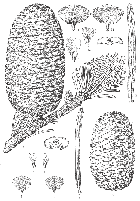
Line drawing of var. nukiangensis; for full size image go to the Flora of China (Wu and Raven 1999).

Line drawing of var. nukiangensis; for full size image go to the Flora of China (Wu and Raven 1999).
Abies delavayi
Delavay fir; 苍山冷杉 cang shan leng shan [Chinese].
A. delavayi was formerly something of a catch-all term for Chinese firs. A. beshanzuensis Wu, A. ziyuanensis Fu et Mo and A. fabri (Masters) Craib have been placed in synonymy by some authors but are here treated as distinct species. A. delavayi var. smithii is a synonym for what for what is here treated as A. forrestii. A. delavayi var. georgei is a synonym for what is here treated as third variety, A. forrestii var. georgei; it has also been called A. georgei. This suite of fir species are now for the most part allied with A. delavayi in Section Delavayi (Farjon 1990, 2010).
There are two varieties retained here, motuoensis W.C. Cheng & L.K. Fu 1975 and nukiangensis (W.C. Cheng & L.K. Fu) Farjon 1990 [syn: A. nukiangensis Cheng et Fu, A. fansipanensis Q.P. Xiang, A. delavayi ssp. fansipanensis (Q.P. Xiang) Rushforth).
"Trees to 25 m tall; trunk to 1 m d.b.h.; bark gray-brown, rough, longitudinally splitting; crown pyramidal; branchlets initially red-brown or brown, then darkened in 2nd or 3rd year, glabrous, rarely pubescent when young; winter buds globose, resinous. Leaves spirally arranged, radially spreading ± forward or pectinately arranged in 2 lateral sets, bright dark green, linear, often curved or "S"-shaped, flattened, 1.5-3 cm × 1.7-2.5 mm, stomatal lines in 2 white bands abaxially, resin canals 2, marginal, margin strongly revolute, apex emarginate. Seed cones shortly pedunculate, black at maturity, glaucous, cylindric or ovoid-cylindric, 6-11 × 3-4 cm. Seed scales flabellate-trapeziform, 1.3-1.5 × 1.4-1.8 cm. Bracts exserted, oblong-spatulate, apex with a narrow, usually recurved cusp 3-5 mm. Seeds obovate; wing brown, cuneate-dolabriform. Pollination May, seed maturity Oct." (Fu et al. 1999).
Abies delavayi var. motuoensis Cheng et Fu differs from the type in having paler, densely ferruginous pubescent young shoots and longer (?) leaves (2-3.2 cm) that are less densely arranged. It has been found in SE Xizang (Tibet) at elevations of 3000-3800 m (Farjon 1990).
Abies delavayi var. nukiangensis (Cheng et Fu) Farjon 1990 has "longer (but variable: 1.2-4.3 cm) and broader (1.5-2.8 mm) leaves, which ... are less revolute. The shoot is purplish-brown and glabrous. The cone is purplish-blue and has the same apically thickened, obtriangular-flabellate seed scales, but included bract scales with a short cusp, which may be barely visible in the lower part of the mature cone. These minor differences do not justify treatment of this material as a species, but deserve recognition as a variety (of lower elevations: 2500-3100 m)" (Farjon 1990).
India: Arunachal Pradesh, Myanmar, Vietnam, China: Yunnan and Tibet at 2400 to 4300 m elevation. In India it is only known from a pure stand atop Piri Mountain, Balipara Frontier Tract. In Myanmar and Vietnam it occurs in the north, and its Chinese/Tibetan distribution is wide through the moist mountain forests of the Four Rivers country at 3000-4300 m. It thus includes NW Yunnan and SE Xizang/Tibet around the Lancang-Nukiang (Mekong-Salween) Divide. The climate is very wet (precipitation 1000-3000 mm), with cool summers and cold winters (snow on the ground from October to April). Soils are grey-brown mountain podzols. It is found on north-facing slopes forming pure (near treeline) or mixed stands with conifers such as Picea likiangensis and P. brachytyla var. brachytyla. At lower elevations it is sometimes mixed with Tsuga chinensis, T. dumosa, Juniperus formosana and broad-leaved trees such as Betula albosinensis, Betula platyphylla var. szechuanica and Quercus semicarpifolia (Liu 1971, Silba 1986, Farjon 1990, Fu et al. 1999).
Hardy to Zone 7 (cold hardiness limit between -17.7°C and -12.2°C) (Bannister and Neuner 2001).
The type variety is found in SE Xizang, NW Yunnan, and N Myanmar at 3300-4300 m elevation. Var. motuoensis is found in SE Xizang (Motuo Xian), at 3000-3800 m elevation. Var. nukiangensis is found in NE India, N Myanmar, N Vietnam (only in Lao Cai on Mt. Fansipan), NW Yunnan and Sichuan in river basins at 2500-3100 m elevation (Fu et al. 1999, Luu and Thomas 2004).
Heights to 40 m and dbh to 150 cm are reported by Liu (1971).
The oldest recorded tree provided 220 years of record (Bräuning 2006), for a tree growing on a young glacial moraine in eastern Tibet. This is a crossdated age on a tree that seems to have been alive when sampled.
The timber is used for construction, furniture, and wood pulp, and the bark yields tannin (Fu et al. 1999).
No data as of 2023.02.22.
Named for its discoverer, Father I.M. Delavay who collected it at 3500-4000 m on Cangshan near Dali in Yunnan, April 1887 (Liu 1971).
Bräuning, Achim. 2006. Tree-ring evidence of ‘Little Ice Age’ glacier advances in southern Tibet. The Holocene 16(3):369-380.
Farjon, Aljos. 1990. Pinaceae: drawings and descriptions of the genera Abies, Cedrus, Pseudolarix, Keteleeria, Nothotsuga, Tsuga, Cathaya, Pseudotsuga, Larix and Picea. Königstein: Koeltz Scientific Books.
Franchet, A. 1899. Plantarum sinensium ecloge tertia. Journal de Botanique 13:255. Available: Biodiversity Heritage Library, accessed 2020.11.26.
The species account at Threatened Conifers of the World.
Cheng, W.C. and L. K. Fu. 1975. Species novae in Gymnospermae Sinicae. Acta Phytotaxonomica Sinica 13(4):83.
Hiep et al. 2004 [as A. delavayi subsp. fansipanensis).
Luu and Thomas 2004 provide a recent description, range map, conservation status, drawings and photos, and a wealth of additional information.
Last Modified 2023-11-06